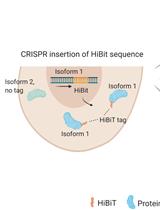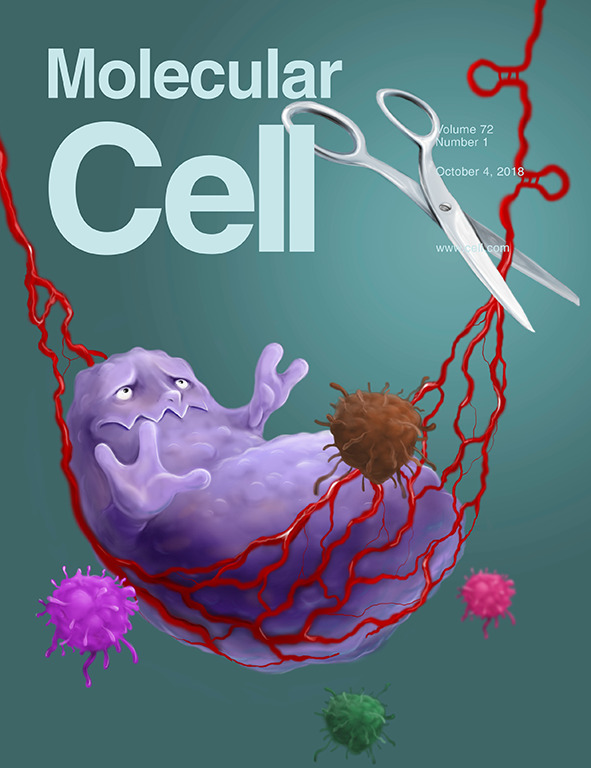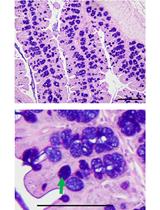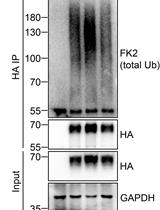- EN - English
- CN - 中文
Measuring Protein Synthesis during Cell Cycle by Azidohomoalanine (AHA) Labeling and Flow Cytometric Analysis
利用叠氮丙氨酸标记和流式细胞分析测定细胞周期中蛋白的合成
发布: 2019年04月20日第9卷第8期 DOI: 10.21769/BioProtoc.3215 浏览次数: 9385
评审: Gal HaimovichAlexandros C KokotosVarpu Marjomaki

相关实验方案

通过CRISPR-Cas9介导的HiBiT标签对高度同源蛋白水平进行异构体特异性半定量测定
Kristina Seiler [...] Mario P. Tschan
2023年07月20日 2183 阅读
Abstract
Protein synthesis is one of the most fundamental biological processes to maintain cellular proteostasis. Azidohomoalaine (AHA) is a non-radioactive and “clickable” amino acid analog of methionine which can be incorporated into newly synthesized proteins. Thus, AHA-labeled nascent proteins can be detected and quantified through fluorescent labeling by "click" chemistry. Here we describe a protocol to measure protein synthesis by AHA labeling and flow cytometry. Taking advantage of gating different cell populations, we provide a typical example of the flow cytometric-based analysis of protein synthesis during the cell cycle. While we used mouse B cells in this protocol this method can be readily applied to any cell types and organisms.
Keywords: Protein synthesis (蛋白合成)Background
Traditionally measurement of protein synthesis is performed by pulse labeling of translation products using radiolabeled amino acids such as [35S]methionine and [35S]cysteine but the use of radioactive materials is the major disadvantage. Recent advance in bio-orthogonal chemical reporters such as azides and alkynes allows us to quantitatively monitor and track biomolecules (proteins, lipids or nucleic acids) through click chemistry (Dieterich, 2010). Azidohomoalaine (AHA) (Figure 1) is a methionine analog that contains an azide moiety and is incorporated into newly synthesized proteins. Thus, nascent proteins can be detected through "click" reaction between AHA (azido) and a fluorescent alkyne (Dieterich, 2010).
Figure 1. Chemical structures of L-methionine and L-azidohomoalaine (AHA)
Measuring protein synthesis during the cell cycle in mammalian cells has been challenging. To do this, cell synchronization in specific phases of the cell cycle is necessary but the use of drugs such as nocodazole was shown to affect translation (Coldwell et al., 2013; Shuda et al., 2015). To measure protein synthesis without drug treatment, here we used metabolic pulse labeling with AHA in a flow cytometric assay (Kiick et al., 2002; Shuda et al., 2015). In combination with AHA, we used anti-phospho-Histone H3 (Ser10) antibody as a mitotic marker to monitor mitotic translation in mouse B lymphoma cells (19DN) (Sander et al., 2015).
Materials and Reagents
- Pipette tips (Eppendorf, epT.I.P.S.)
- 6-well plate (Thermo Fisher Scientific, BioLite 6-well Multidish, catalog number: 130184)
- 96-well U- or V-bottom cell culture plate (Corning, catalog number: 6902D09 or 6928A17)
- 5 ml round bottom polystyrene FACS tube (Falcon, catalog number: 38007)
- L-Azidohomoalanine (AHA) (Anaspec, catalog number: AS-63669, 500 mM stock solution in deionized water, keep at -20 °C up to at least a few months)
- Methionine-free medium such as Dulbecco’s Modified Eagle’s Medium–high glucose With 4,500 mg/L glucose and sodium bicarbonate, without L-methionine, L-cystine and L-glutamine, liquid, sterile-filtered, suitable for cell culture (Merk, catalog number: D0422)
- Fetal bovine serum, South America origin, dialyzed, sterile filtered (Pan Biotech, catalog number: P30-2102)
- L-Methionine (Merck, catalog number: M9625, make 300 mM stock solution in deionized water, keep at -20 °C up to at least a few months)
- L-Cystine dihydrochloride (Merck, catalog number: C2526, prepare fresh 200 mM (1,000x for DMEM) solution in deionized water)
- GlutaMAX (Thermo Fisher Scientific, catalog number: 35050061, 200 mM stock solution)
- D-PBS (1x), no calcium chloride, no magnesium chloride, sterile-filtered (Thermo Scientific Fisher, catalog number: 14190144)
- Alexa Fluor488 alkyne (Thermo Fisher Scientific, catalog number: A10267)
- Phospho-Histone H3 (Ser10) (D2C8) XP Rabbit mAb (Alexa Fluor 647 Conjugate) (Cell Signaling Technology, catalog number: 3458S)
- (+)-Sodium L-ascorbate (Merck, catalog number: A7631)
- Copper(II)-Sulphate (CuSO4) (Baseclick, catalog number: BCMI-004-50)
- Paraformaldehyde (PFA) (Roth, 335)
- Saponin (Sigma-Aldrich, catalog number: 47036)
- (Optional) Triton X-100 (Sigma-Aldrich, catalog number: T9284)
- Bovine serum albumin (BSA) (Roth, 8076)
- DMSO (Merck, catalog number: D8418)
- EDTA (Merck, catalog number: EDS)
- NaN3 (Merck, catalog number: 71289)
- Cycloheximide (Santa Cruz Biotechnology, catalog number: sc-3508)
- Cell culture medium for AHA labeling (w/o methionine or AHA) (see Recipes)
- Washing solution (see Recipes)
- Fixing solution (see Recipes)
- Permeabilization solution (see Recipes)
- FACS buffer (see Recipes)
Equipment
- (Optional) Multi channel pipette (Eppendorf, catalog number: 3122 000.043 [10-100 μl])
- CO2 Incubator (Thermo Fisher Scientific, catalog number: 51026331)
- Refrigerated centrifuge (Eppendorf, models: 5418 R [fixed angle for tubes], 5804 R [swing out for 96 well plates])
- Flow cytometer (FACS Aria instrument) (BD Biosciences)
Software
- Analysis Software: FlowJo
Procedure
文章信息
版权信息
© 2019 The Authors; exclusive licensee Bio-protocol LLC.
如何引用
Imami, K. and Yasuda, T. (2019). Measuring Protein Synthesis during Cell Cycle by Azidohomoalanine (AHA) Labeling and Flow Cytometric Analysis. Bio-protocol 9(8): e3215. DOI: 10.21769/BioProtoc.3215.
分类
癌症生物学 > 通用技术 > 生物化学试验 > 蛋白质分析
细胞生物学 > 细胞染色 > 蛋白质
您对这篇实验方法有问题吗?
在此处发布您的问题,我们将邀请本文作者来回答。同时,我们会将您的问题发布到Bio-protocol Exchange,以便寻求社区成员的帮助。
提问指南
+ 问题描述
写下详细的问题描述,包括所有有助于他人回答您问题的信息(例如实验过程、条件和相关图像等)。
Share
Bluesky
X
Copy link










